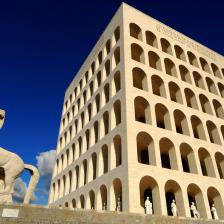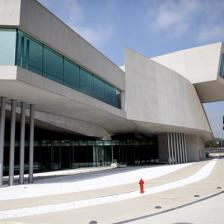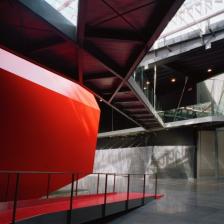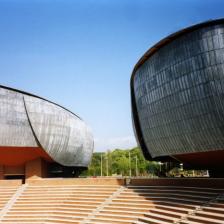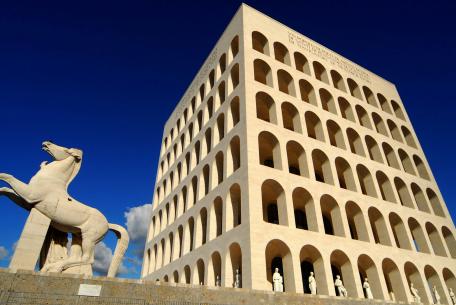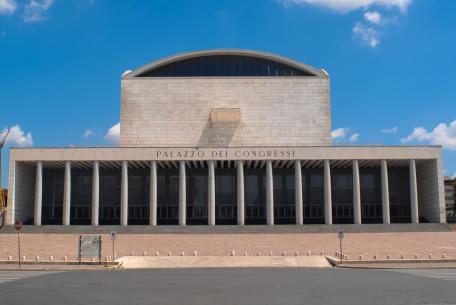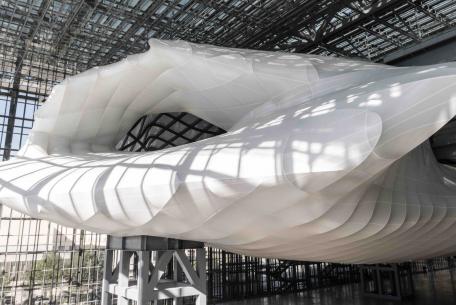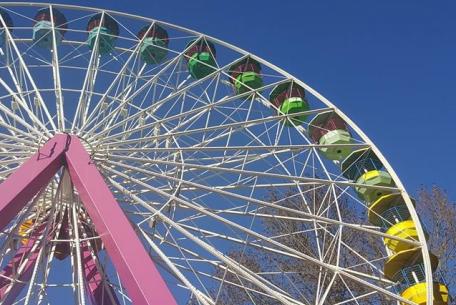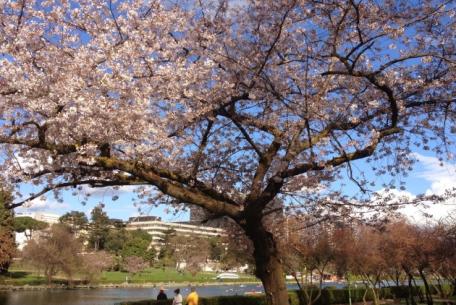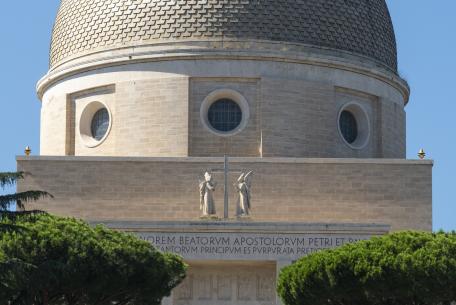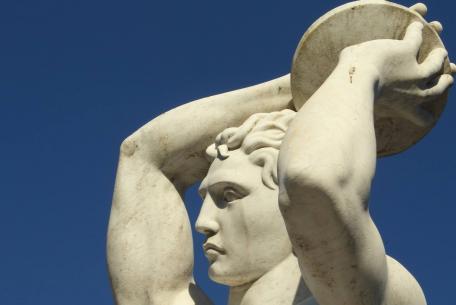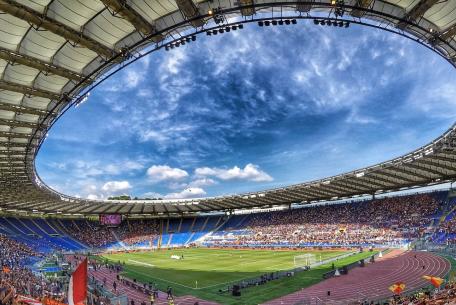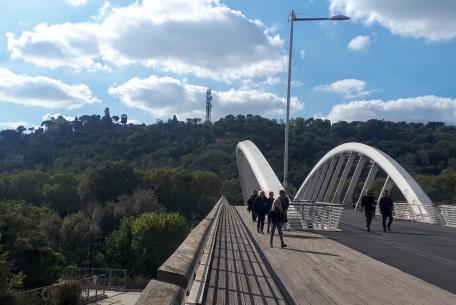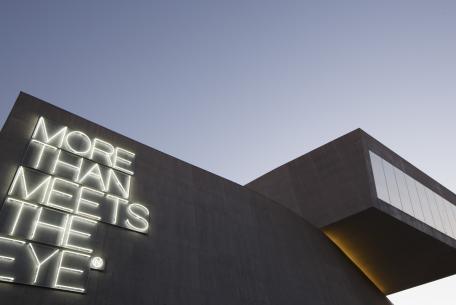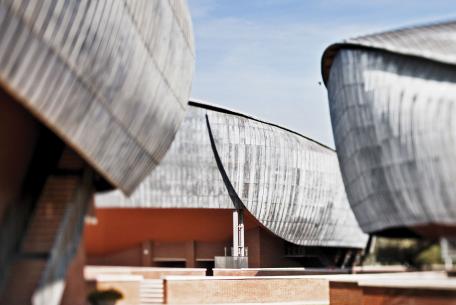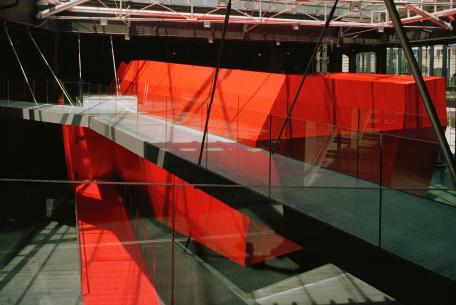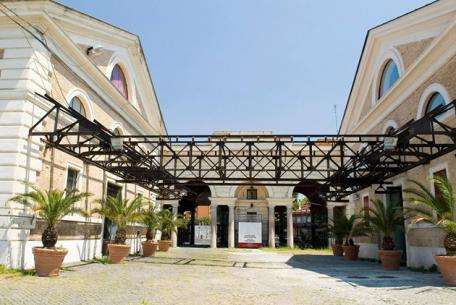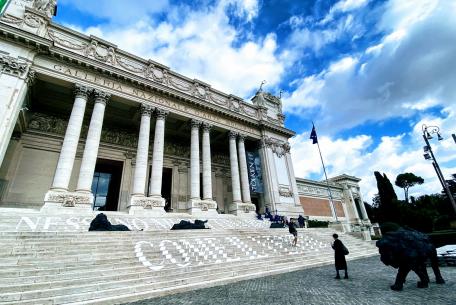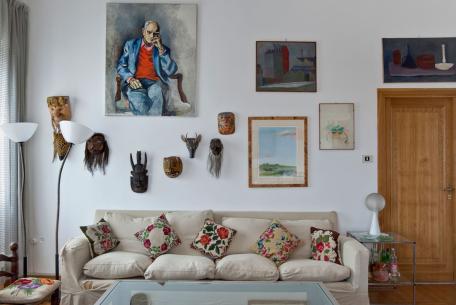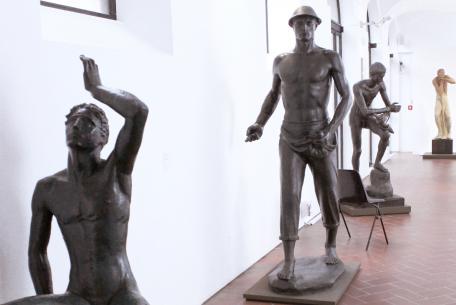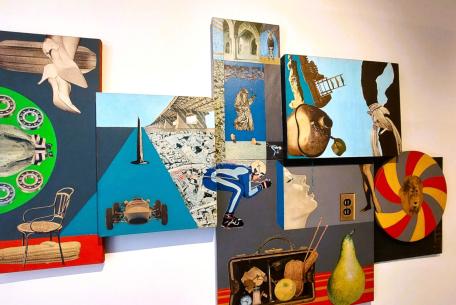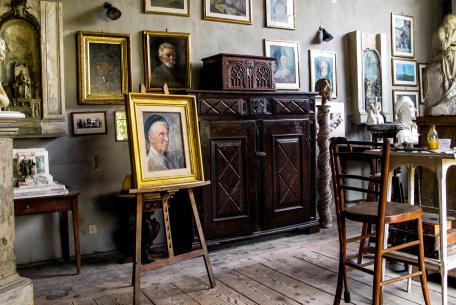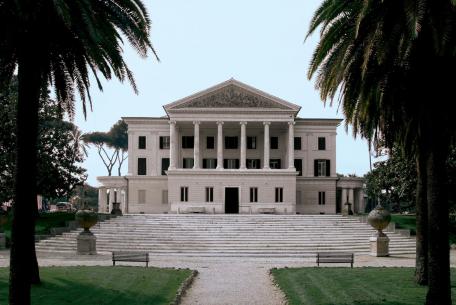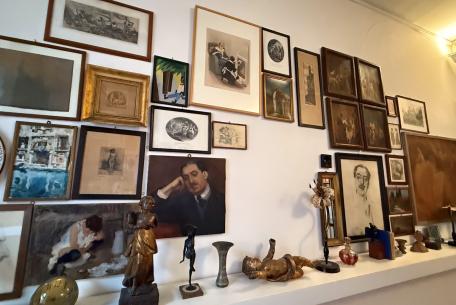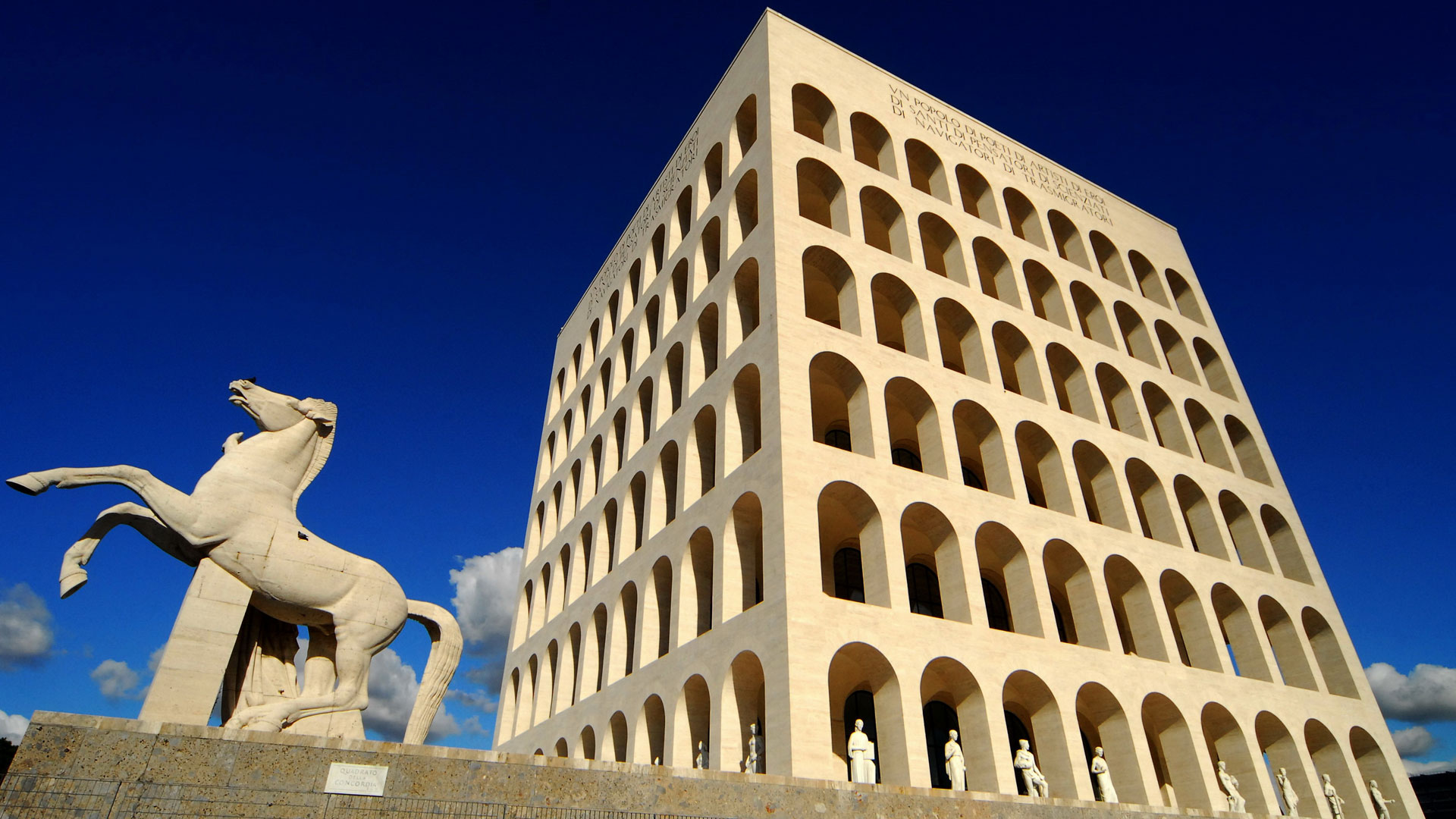
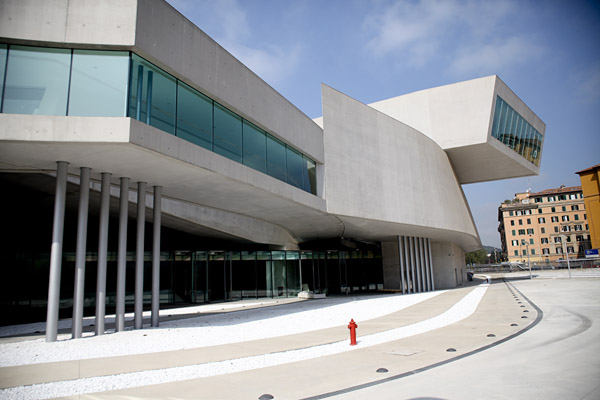
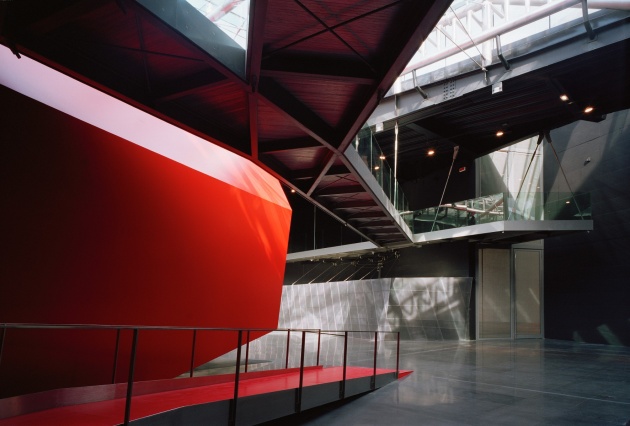
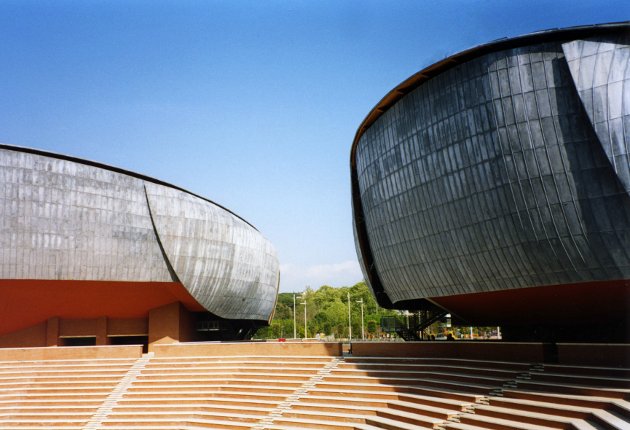
Though in people’s minds Rome has always been considered the capital of archaeology and ancient times, it is actually an eclectic container of the many styles harmoniously overlaid during the centuries. Rome was able to take up the challenge of contemporary times putting in place innovative urban planning solutions and giving space to new forms of art expression such as futuristic buildings designed by famous architects and spaces dedicated to the street art.
Three itineraries to discover contemporary art in Rome.
Itinerary 1 South of Roma - E.U.R., Church of Santo Volto di Gesù, Tor Marancia
The tour begins from E.U.R. southwest area of Rome. It is a residential district characterized by a rationalist architecture, conceived to host the 1942 Universal Exposition of Rome never realised because of the Second World War’s outbreak.
The first pentagonal shaped project conceived upon an ideal city’s model, was developed by a group of architects led by Marcello Piacentini. It mainly concerned big buildings and structures specifically conceived for the exposition as well as services and connections aiming at showing the city extending towards the seaside.
As soon as you reach EUR district you will see two main symmetrical buildings Palazzo della Civiltà Italiana and Palazzo dei Congressi standing on the two sides of Via Cristoforo Colombo and connected by Viale della Civiltà del Lavoro. The first building, so called “Square Colosseum” is 68 metres high and looks like one enormous block of travertine. Today, it has been granted to Fendi Maison that opens the ground floor to visitors at its temporary exhibitions. Palazzo dei Congressi, planned by Adalberto Libera as a space for entertainment and big events, is the result of a contamination between neoclassic style and functional style. Both the facades are decorated by big windows and the space inside is decorated with mosaics of the period. The upper terrace hosts an open theatre where shows and cultural events still take place.
Walking a little bit ahead you will reach Piazzale Marconi that you will recognize thanks to the white obelisk stunning in the middle of the square surrounded by the buildings hosting the MuCiv - Museo delle Civiltà collections.
On the highest point of the Eur district, stands the Basilica of Saints Peter and Paul. Built in travertine, conceived with a central plan and a Greek cross, the church has a hemispherical dome which, with its diameter of 32 meters, is one of the most impressive in Rome.
The district was completed during the 50s and 60s with the construction of public and residential buildings. Nowadays E.U.R has become a new hub for congress tourism thanks to the new Congress Centre “La Nuvola” (The Cloud), designed by Massimiliano Fuksas, made of steel and glass and formed by a congress hall able to host up to 8,000 people as well as offices, shops, refreshment areas and a big four star hotel.
In E.U.R. you can also go shopping choosing between the many shops along Viale Europa and the shopping mall Euroma2, or you can enjoy a few hours with your family to Luneur, the new theme park dedicated to the small children with its carousels and the panoramic wheel. Alternatively, you can go running or walking in the green area surrounding the small lake, the Laghetto, where it is also possible to hire a pedal boat or a canoe.
In Portuense district, not too far from E.U.R., you can visit the modern catholic church called Santo Volto di Gesù, planned by Piero Sartogo and Nathalie Grenon and inaugurated in 2006. It represents one of best examples of contemporary architecture in Rome. From outside, the wide window lightening the altar stands out together with the big cross realized by Eliseo Mattiacci. Inside, the fluid space welcomes the faithful, while the glazed ceramic shapes made by Mimmo Paladino mark the rhythm of the Stations of the Cross. In the Holy Sacrament’s chapel there is an abstract design window by Carla Accardi and a shining sculpture by Chiara Dynys.
Coming back towards the centre along Via Cristoforo Colombo you will cross Viale di Tor Marancia, which takes its name from the district surrounding it, nearby the building of Regione Lazio. A wonderful street art project entitled Big City Life was realized on the compound’s walls at n. 63 in 2015, launching a real contemporary art open air museum. Twenty artists from all over the world realized their colourful murals thus restyling the building facades facing the wide courtyard, a gathering point for all age inhabitants who had an active part in the work. They afterwards formed a cultural association that organizes guided tours and promotes initiatives to enhance them.
Itinerary 2 - North of Roma Foro Italico, Farnesina, Bridge of Music, Auditorium, MAXXI
North of Rome the huge area between Foro Italico and Flaminio District was involved in several urban reorganizations and redevelopment works during the last century so much to make it become an everlasting work in progress for new ideas and projects.
The tour starts from Foro Italico, the massive sports centre at the foot of Monte Mario hill, inaugurated in 1932. Conceived as an area dedicated to sports disciplines, it is nowadays a sports hub for the many athletic events taking place in the Capital. Strolling in the outside area you will admire a lot of mosaics celebrating sports disciplines through zoomorphic representations, athletes, inscriptions and dedications.
Walking throughout the Forum you will visit the impressive and spacious Stadio dei Marmi completely built in Carrara’s white marble and surrounded by big statues personifying sports disciplines. Polychrome mosaics celebrate sports activities showing handsome athletes in the covered swimming pool. The Casa della Scherma, only visible on special occasions, is divided into two sections and decorated according to the rules of rationalist style. Stadio Olimpico is also part of this sports centre. Built to host the 1960 Olympiads it can accommodate up to 72,700 people ranking second in Italy for capacity. Today it is the seat of the main sports events and several concerts.
Continuing slightly northwards you will reach Piazza della Farnesina where you will meet the Ministry of Foreign Affairs initially designed to be the seat of the Fascist Party. Its monumental shape is characterized by a massive facade and the big sphere by Arnaldo Pomodoro dominates the square in front of it. Contemporary art extraordinary collections are held inside the Ministry and occasionally open to visitors with organised guided tours.
Once you are in Lungotevere Cadorna you can cross the river through Ponte della Musica – Armando Trovajoli. This elegant structure built with steel, wood and reinforced concrete is 190 metres long. Pedestrians, electric buses and bicycles only are allowed on it.
Once you have crossed Ponte della Musica and Piazza Gentile da Fabriano you can walk along Via Guido Reni for 400 metres until you reach MAXXI Museum. The two main sections: MAXXI arts and MAXXI architecture embrace the hall leading to the various services: reception, cafeteria, book shop, educational labs, auditorium, conference and exhibition halls. Realized by the anglo-iraqi architect Zaha Hadid after winning an international competition in 1998, MAXXI Museum is made of light grey concrete and is 30,000 square metres spread out. The inside layout bases on continuous space crossing throughout which the visitor can freely move thanks to always different tours. A constant dialogue with the urban environment surrounding the museum can be considered the key to its success. In fact, the outside space has been conceived as a square where inhabitants, tourists and families have free access.
Leaving MAXXI Museum you can walk along Via Guido Reni, cross Piazza Apollodoro, then walk by Palazzetto dello Sport and continue on Viale Pietro de Coubertin where you will find the amazing Auditorium Parco della Musica. It is a lively example of architecture dedicated to national and international music events. Designed by Renzo Piano the Auditorium develops into three concert halls: Sala Santa Cecilia ( symphonic concerts, big orchestra and choir), Sala Sinopoli (suitable for various types of music) and Sala Petrassi (contemporary music, theatre and movie performances). Not to be missed also the Teatro Studio a multifunction area provided with 350 seats and the Cavea an amphitheatre hosting up to 3,000 people. People can as well relax in the cafeteria, the restaurant and the big book shop.
Itinerary 3 Museums and cultural spaces
Polo del Contemporaneo e del Futuro di Roma
Palazzo delle Esposizioni is an historic seat for art exhibitions, among them Rome’s Quadrennial promotes expositions as well as congresses and film festivals.
MACRO is located in the former Peroni’s factory in via Nizza. Their annual festivals have become a must for Romans and foreigners as well as their educational labs and their guided tours for adults and children.
Mattatoio (the former Slaughterhouse) in Testaccio district, also includes the Centro di produzione culturale La Pelanda, a space of 5,000 square metres open during exhibitions, trainings, and labs.
Contemporary Art Museums
- La Galleria Nazionale, nearby Villa Borghese, is the most important museum of Rome dedicated to the XIX and the XX century’s arts. Recently restyled, it hosts both permanent collections and temporary thematic exhibitions.
- The Alberto Moravia House Museum, house of the great writer inside a building of the 30s facing the Tiber. Today, it is the site of foundation managing the archive and the library.
- The Galleria d’Arte Moderna di Roma Capitale, located in via Francesco Crispi offers a collection documenting Rome’s artistic environment between the second half of the XIX Century and the second post-war.
- The Carlo Bilotti Museum consisting of the works of art collected by Carlo Bilotti, a businessman known all over the world. The museum is located inside Villa Borghese’s Orangery.
- The Pietro Canonica Museum, Pietro Canonica’s house on the first floor and his atelier as well as his most important works of art that go from the small busts to the big equestrian statues, located inside Villa Borghese too.
- The Museums of Villa Torlonia, located along via Nomentana in a wide public park, they are divided into several eclectic-style buildings. The Casina delle Civette is the most famous and it is characterized by artistic windows and liberty style decorations.
- The Museum of Roma in Trastevere hosting paints and prints, as well as Ettore Roesler Franz’s Rome’s watercolours, telling Roman people’s everyday life from the end of the XVIII Century to the first years of the XX Century.
 Condividi
Condividi












































